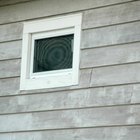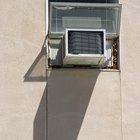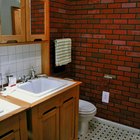
Medioimages/Photodisc/Photodisc/Getty Images
In the search for new sources of energy, many homeowners are turning to the sun to provide electricity and heat. Passive solar heating — using the sun’s natural light and heat to warm your home — is a way to both reduce your heating bills and lower the amount of greenhouse gases your family produces. Passive solar heating is not appropriate for every home and every situation, however, and there are certain disadvantages to relying on the sun to heat your home.
Reliability
One of the major drawbacks of passive solar is that heating your home depends entirely on the weather. While many passive solar designs include features to maximize heating from the smallest exposure to the sun’s warmth, bad weather can leave your home feeling cold and dreary. A prolonged winter storm can rob your home of heat at the worst possible time.
Location
Not every region of the country receives enough sustained sunlight to make solar heating a good option. In northern climates, the harsh winters can overwhelm a passive solar heating system, making supplemental heating a must to keep your home at a comfortable temperature. Installations in colder areas also require more, and costly, insulation to keep heat from radiating back out through windows. In southern areas, prolonged sunlight can overheat your home, leaving it uncomfortably hot in the milder climate. A poorly designed passive solar system in a warmer area can lead to increased cooling costs, and can quickly eat up any savings offered by utilizing the sun’s warmth.
Cost
While passive solar produces free heat once installed, designing your home to take advantage of solar heating can be an expensive process. Choosing the proper windows is important, as some types of glass filter out more of the sun’s energy and are unsuitable for passive solar installations. Redesigning rooms to use heat-absorbent materials can require remodeling, and even replacement of interior and exterior walls, to get the best effect.
Design
The idea of passive solar heating is simple, but using it effectively can require precisely configuring parts of your home to take advantage of the angle of the sun. Properly designed overhangs can let in welcome warmth in the winter months and block the sun’s heat in the summer. Bad design, however, can produce too much heat and glare when it is not welcome, and leave your home cold in the wintertime. Consulting with a professional can mean the difference between a passive solar heating system that works and one that does not.
Related Articles

Example of Passive Solar Energy

Appliances That Use Solar Energy

Uses of Thermal Insulators

Requirements for Window Replacement in ...

Types of Hotel Rooms

How to Transport the Deceased From One ...

How to Get a Good Tan From a Sun Lamp

The Best Places to Live in California ...

Can You Pour Boiling Water Into a ...

The Purpose of a Heat Exchanger

Casio G-Shock Atomic Time Set ...

Top Ten Places to Retire in Colorado

How Long Can I Keep Food Safe in a ...

How Can I Fade Levi's?

Free Places to Get Married

Handicapped Bathroom Grants for Veterans

What Are the Advantages of Nursing ...

The Difference Between a Chafing Dish & ...

Beaches Near Greenville, North Carolina

What Is the Difference Between Wet & ...
References
Writer Bio
Milton Kazmeyer has worked in the insurance, financial and manufacturing fields and also served as a federal contractor. He began his writing career in 2007 and now works full-time as a writer and transcriptionist. His primary fields of expertise include computers, astronomy, alternative energy sources and the environment.
Photo Credits
Medioimages/Photodisc/Photodisc/Getty Images